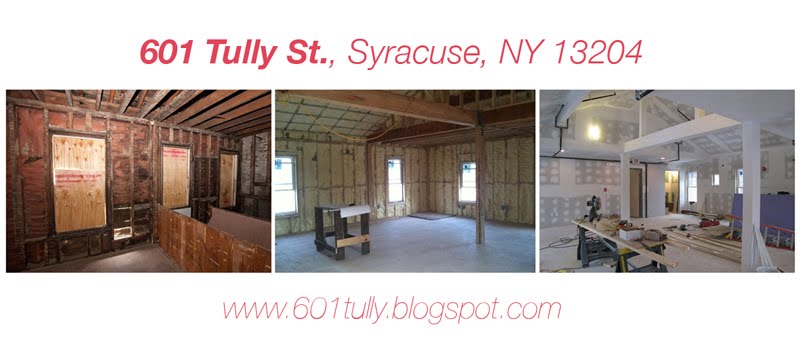About 601 Tully
Check out our new website! 601Tully.syr.edu
601 Tully is a center for engaged practice in Syracuse, NY developed by artist and professor Marion Wilson with a rotating collaborative team of 54 students and neighbors and Anda French of French 2Design. It's a site for meaningful exchange between artists, community members, and scholars in the co-production of culture.
601 Tully includes a contemporary art space, a public events space, a bookstore, a teaching garden, and Recess Cafe West.
In 2009, Wilson purchased the condemned two-story home and local drug hub, and throughout five semesters, Wilson's design/build class re-zoned, designed, renovated and now sustains the physical and programmatic aspects of 601 Tully. The collaborative team has consisted of artists, architects, environmentalists, Fowler High School students, Green Train Workforce, neighbors, and the occasional passerby.
601 Tully is made possible by the generous support of the Syracuse University School of Education, The Kauffman Foundation, The Near West Side Initiative, Imagining America, Home HeadQuarters Inc., Say Yes to Education, and National Grid.
Find us on Facebook!
Thursday, November 18, 2010
Community Artist:Artist Community
What I see as key to the project's determination of success was its continuation despite an eventual disassociation from its original and major instigator, Sculpture Chicago. The participant group in this "new genre public art" took hold of the project or "piece" and made it their own, fueling its growth and developing it into a full-fledged program that they themselves found value in maintaining almost 15 yrs later. I think it's an important quality to be able to recognize the opportunitites in one's own context, socially, relationally, ideologically, etc. This artist had "the home-field advantage" and saw the possibilities that they could work within to affect their own context to the advantage of the community. This notion has profound implications especially today with the reality of globalization in the large scale and the access we have to specialists, professional, etc, who come from entirely different backgrouds, all the way down to the town or city scale. At the very least this example reinforces the importance of relationships and communication with the communities affected by or involved with a project, building into them and having them build into the project. More importantly, however, it signifies the potentialities for artists, designers, and creatives alike that lay waiting right in front of us.

No comments:
Post a Comment